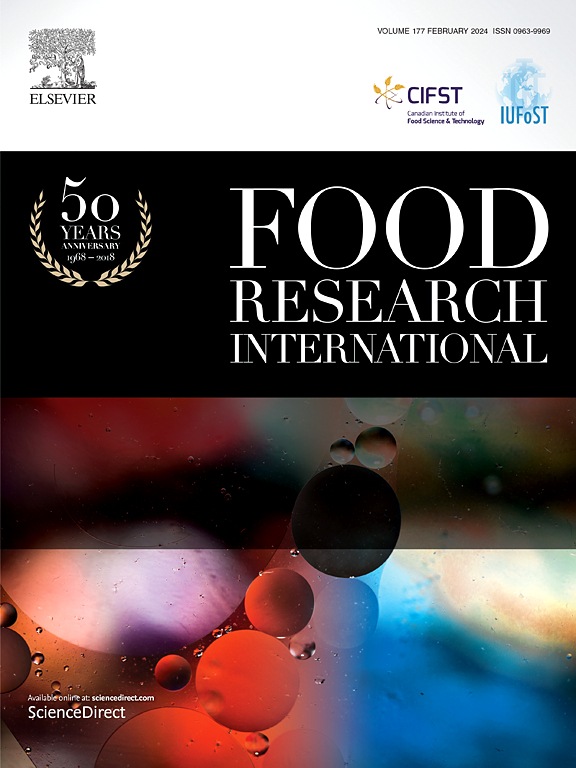In vitro infant fecal fermentation characteristics of bovine milk osteopontin and 2′-fucosyllactose combination
IF 8
1区 农林科学
Q1 FOOD SCIENCE & TECHNOLOGY
引用次数: 0
Abstract
Breast milk is rich in bioactive proteins and oligosaccharides, including osteopontin (OPN) and 2′-fucosyllactose (2’-FL), which are believed to promote the growth of beneficial microbiota and regulate intestinal barrier function. In this study, fermentation substrates including DOPN (digested OPN fragment), 2’-FL and their combinations in varying proportions, were prepared through in vitro gastrointestinal digestion, dialysis and freeze-drying. Changes in gas production, organic acid levels, ammonia N concentration and bacterial population abundance were studied using an in vitro batch fermentation model, with feces inocula from healthy infants. Results showed that DOPN fermentation by colonic microorganisms produced approximately 1.7 mL of total gas, with acetate (28.6 mM) as the predominant metabolite, along with lower levels of propionate (3.9 mM) and branched chain fatty acids (2.7 mM), accompanied by a substantial accumulation of ammonia N (504.6 mg/L). When the DOPN and D2’-FL ratio ranged from 1:36 to 1:3, the mixture exhibited a pronounced bifidogenic effect, with the relative abundance of B. longum reaching 42–56 %. This was accompanied by sustained high production of acetate (55.0–59.9 mM), lactate (8.5–11.1 mM) and succinate (3.2–3.8 mM), while protein fermentation by-products, such as ammonia N, remained at low levels (8.3–104.6 mg/L). Taken together, the combination of OPN and 2’-FL established a synergistic microenvironment that enhanced both microbial diversity and metabolite functionality, providing a biochemical basis for their potential application in infant formula products.

乳汁骨桥蛋白与2′-焦酰基乳糖组合体外发酵婴儿粪便特性研究
母乳中含有丰富的生物活性蛋白和低聚糖,包括骨桥蛋白(OPN)和2 ' -聚焦乳糖(2 ' - fl),它们被认为可以促进有益菌群的生长,调节肠道屏障功能。本研究通过体外胃肠消化、透析和冷冻干燥制备不同比例的DOPN(被消化的OPN片段)、2′-FL及其组合发酵底物。以健康婴儿粪便为接种物,采用体外分批发酵模型,研究了产气量、有机酸水平、氨氮浓度和细菌种群丰度的变化。结果表明,大肠微生物发酵DOPN产生的总气体约为1.7 mL,其中乙酸(28.6 mM)为主要代谢物,丙酸(3.9 mM)和支链脂肪酸(2.7 mM)含量较低,氨氮(504.6 mg/L)大量积累。当DOPN和D2′-FL比在1:36 ~ 1:3范围内时,双歧杆菌的相对丰度达到42 ~ 56%。伴随着乙酸(55.0-59.9 mM)、乳酸(8.5-11.1 mM)和琥珀酸(3.2-3.8 mM)的持续高产,而蛋白质发酵副产物,如氨氮,则保持在较低水平(8.3-104.6 mg/L)。综上所述,OPN和2′-FL的结合建立了一个协同微环境,增强了微生物多样性和代谢物功能,为它们在婴儿配方奶粉产品中的潜在应用提供了生化基础。
本文章由计算机程序翻译,如有差异,请以英文原文为准。
求助全文
约1分钟内获得全文
求助全文
来源期刊

Food Research International
工程技术-食品科技
CiteScore
12.50
自引率
7.40%
发文量
1183
审稿时长
79 days
期刊介绍:
Food Research International serves as a rapid dissemination platform for significant and impactful research in food science, technology, engineering, and nutrition. The journal focuses on publishing novel, high-quality, and high-impact review papers, original research papers, and letters to the editors across various disciplines in the science and technology of food. Additionally, it follows a policy of publishing special issues on topical and emergent subjects in food research or related areas. Selected, peer-reviewed papers from scientific meetings, workshops, and conferences on the science, technology, and engineering of foods are also featured in special issues.
 求助内容:
求助内容: 应助结果提醒方式:
应助结果提醒方式:


